216. The wooden bowl could
have referred to the polar 'cap', which together
with its complementary twin the 'cup'
constituted the top and bottom pieces of the celestial sphere.
The banner
of the Incas had a pair of 'water
serpents' below a coloured 'rainbow' (hanuanua meamea)
semicircle, from the center of which a red
cap-like object was hanging down:
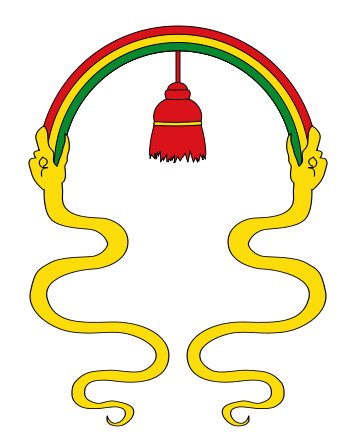
... In South America the rainbow has a
double meaning. On the one hand, as
elsewhere, it announces the end of rain; on
the other hand, it is considered to be
responsible for dis-eases and various natural
dis-asters. In its first capacity
the rainbow effects a dis-junction between
the sky and the earth which previously were
joined through the medium of rain. In the
second capacity it replaces the normal
beneficient con-junction by an abnormal,
maleficient one - the one it brings about
itself between sky and earth by taking the
place of water
...
... The Katawihi distinguish two
rainbows: Mawali in the west, and
Tini in the east. Tini and
Mawali were twin brothers who brought
about the flood that inundated the whole
world and killed all living people, except
two young girls whom they saved to be their
companions. It is not advisable to look
either of them straight in the eye: to look
at Mawali is to become flabby, lazy,
and unlucky at hunting and fishing; to look
at Tini makes a man so clumsy that he
cannot go any distance without stumbling and
lacerating his feet against all obstacles in
his path, or pick up a sharp instrument
without cutting himself
...
|
Tini. To
be at the zenith: ku-tini-á te
raá; middle of a journey, of a
period of time; te tini o te raá,
the middle of the day. Vanaga.
1. A great number,
innumerable, infinite, indefinite.
Tinitini, million, billion. T
Pau.: tinitini, innumerable.
Mgv.: tini, a countless
number, infinite. Mq.: tini,
id. Ta.: tini, numerous. 2.
Raa tini, noon; tini po,
midnight; te tini te raa,
zenith; topa tini, abortion.
Churchill. |
|
Vari. 1.
Menstruation, period (also: tiko).
2. To tack, to veer (nautical);
ku-vari-mai-á te miro, the boat
arrives, have veered [around Rano
Kau]. Vanaga.
About,
circumference, to turn in a circle;
hakavari, pliant, to bend,
square; varivari, about, to
go around; vavari, a garland;
varikapau, circumference, to
surround, a compass, to admire;
hiriga varikapau, to go in a
ring; pa varikapau, to close
in; varitakataka (vari-taka
3) to surround. Churchill.
Pau.: Vari,
marsh, mire, dirt. Ta.: vari,
dirt, mud. Rar.: vari, mud.
Churchill. Mgv.: Vari, paste
well diluted. Mq.: vaivai, to
dilute, to thin. Ha.: waliwali,
soft, pasty. Churchill. |
... The Mura also believed that there
were two rainbows, an 'upper' and a 'lower'
... Similarly, the Tucuna
differentiated between the eastern and the
western rainbows and believed them both to
be subaquatic demons, the masters of fish
and potter's clay respectively ...
|
LIBRA: |
|
16 |
Visakha |
α,
β,
γ
and
ι
Librae |
Triumphal arch,
potter's wheel |
Oct 31 |
|
PISCES: |
|
28 |
Revati |
ζ Piscium |
Fish
or a pair of fish, drum |
Apr 6 |
One of these 'rainbows' could possibly have
referred to the time when the Sea Beast
opened his mouth wide at Menkar (α Ceti), to
let his red gills become visible, and the
other one should then be at the opposite side of
the year, at Libra. 304 (October 31) - 49
(February 18) = 255 (= 471 - 216 = 355 - 100
= 183 + 360 / 5).
Or α Librae (*224) - ζ Piscium (*16) = *208
(= 16 * 13) = *183 + *25. Or *208 + *16 =
*224 (= 32 * 7).

... The Babylonian Rainbow was like a
bridge between the Stag and
Anunitum:
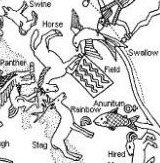
And the Wing of the Pegasus Horse was where the
Babylonians had their 1-iku
constellation, ruled by Anunitum (τ
Piscium) - whereas the Wing (Gienah) of
Raven was when in rongorongo times the Sun
reached the southern spring equinox in
September.

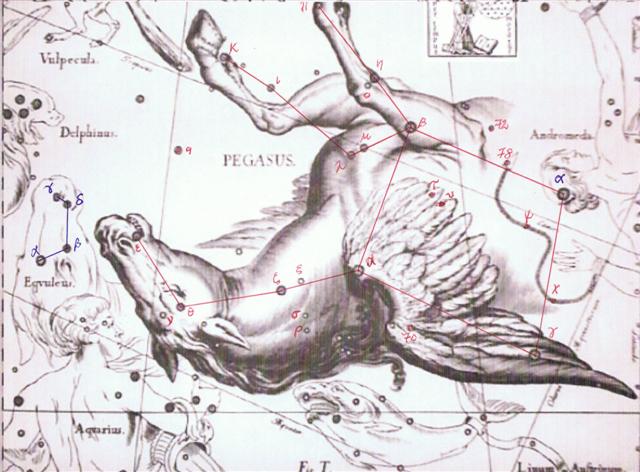
... South of the equator the Rainbow
of the Babylonians seems to have
corresponded to a double bow sign at the
rain junction (te ua) where Sky and
Earth lay in primal embrace:
... Sky (rangi) and Earth (papa)
lay in primal embrace, and in the cramped,
dark space between them procreated and gave
birth to the gods such as Tane,
Rongo and Tu. Just as children
fought sleep in the stifling darkness of a
hare paenga, the gods grew restless
between their parents and longed for light
and air. The herculean achievement of
forcing Sky to separate from Earth was
variously performed by Tane in New
Zealand and the Society Islands, by
Tonofiti in the Marquesas and by Ru
(Tu) in Cook Islands. After the sky
was raised high above the earth, props or
poles were erected between them and light
entered, dispelling the darkness and
bringing renewed life. One detail which is
iconographically of interest is whether the
god responsible for separating Earth and Sky
did so by raising the Sky with his upraised
arms and hands, as in Tahiti and elsewhere,
or with his feet as in New Zealand
...
|
 |
 |
|
ua |
toga |
 |
 |
 |
 |
|
Cb2-4 (420 = 285 + 135) |
Cb2-5 (392 + 29) |
Cb2-6 (30) |
Cb2-7 |
|
te ua |
koia ra |
kua tuku ki to
mata - ki tona tukuga |
e kiore -
henua
-
pa rei |
|
INVISIBLY CLOSE TO THE SUN
(helical dates): |
|
π Cor.
Borealis,
UNUK ELHAIA
(Necks
of the Serpents) = λ Serpentis
(238.1),
CHOW = β Serpentis
(238.6) |
κ Serpentis (239.3), δ Cor.
Borealis,
TIĀNRŪ = μ Serpentis
(239.5), χ Lupi, (239.6), ω
Serpentis (239.7),
BA (= Pa) = ε Serpentis,
χ Herculis (239.8). κ Cor.
Borealis, ρ Serpentis (239.9) |
λ Librae (240.0), β Tr. Austr.
(240.3), κ Tr. Austr. (240.4), ρ
Scorpii (240.8) |
Iklīl al Jabhah-15 (Crown of the
Forehead) /
Anuradha-17 (Following
Rādhā)
/
Room-4 (Hare)
ξ Lupi, λ Cor. Bor.(241.1),
ZHENG = γ Serpentis,
θ Librae (241.2),
VRISCHIKA = π Scorpii
(241.3), ε Cor. Borealis
(241.5), DSCHUBBA
(Front of Forehead)
m = δ Scorpii
(241.7), η Lupi (241.9) |
|
Nov 14 |
15 |
16 (320) |
17 |
|
ºNov 10 (314 = 318 - 4) |
11 |
12 |
13 |
|
'Oct 18 (291 = 318 - 27) |
19 |
20 |
21 |
|
"Oct 4 (277 = 318 - 41) |
5 |
6 |
7 |
|
SEPT 11
(254 = 318 - 64) |
12 |
13 |
14 |
|
234 = 318 - 84 |
235 |
236 (= 8 * 29½) |
237 |
|
Pa.
1. Mgv.:
pa, an inclosure, a
fenced place. Ta.: pa,
inclosure,
fortification. Mq.:
pa, inclosure. Sa.:
pa, a wall. Ma.:
pa, a fort. 2.
Mgv.: pa, to
touch. Sa.: pa'i,
id. Ma.: pa, id.
3. Mgv.: pa, to
prattle. Ta.:
hakapapa, to
recount. 4. Mq.: pa,
a hook in bonito
fishing. Sa.: pa,
a pearlshell fishhook.
Ma.: pa, a
fishhook.
Pau.:
hakapa, to feel, to
touch. Mgv.: akapa,
to feel, to touch, to
handle cautiously.
ε, of 3.7 magnitude, was Pa,
the name of a certain territory
in China. (Allen) |
|
Pae.
1. To
end, to come to an end;
ku-pae-á taaku kai,
I have no more food;
pae-atu, to leave
en masse;
ku-pae-atu-á tagata ki
Hangaroa tai.
everybody has left for
Hangaroa Bay. 2.
To start, to break out
(of wars, fights:
taûa); ku-pae-á
te taûa, the fight,
the war, has started. 3.
Dressed, edged stones
anciently used to
enclose a permanent
umu; paepae
wall of undressed stones
built as protection
against the wind; also
any other protection.
Pa'e: Of a boat, to
deviate, to drift, to
stray under the effects
of currents or winds;
ku-pa'e-á te vaka i te
tokerau, the wind
has made the boat
deviate from its course.
Vanaga.
Paega: 1. Dressed
stones forming the
foundations of the
ancient houses or of the
walls of the monumental
ahus; hare
paega, house with
stone foundations;
paega-ahu, ahu wall.
2. Household, people who
live in a hare paega.
3. To lay stones on the
bottom and against the
sides of a hole:
he-paega i te rua.
Vanaga.
1.
Enough. 2. Division of a
subject (paiga).
Pau.: paega, a
party, a side. Ta.:
pae, division, part.
3. Threshold, sill,
joist. P Ta.: pae,
sill, joist. 4. To
exhaust, to finish,
past; e ko pae,
impregnable; hakapae,
to exhaust, to finish,
to end, to execute, to
accomplish, to conclude,
to consummate, to
consume, to achieve, to
acquit. Paea: 1.
Enough, past. 2. To
decay, to waste away;
paea tooa, to
deprive. Paega,
foundation. Paepae,
pavement, plank, canoe;
hakapaepae, to
lay planks, to floor. P
Pau.: paepae, a
raft. Mgv.: paepae,
a pavement, to lay up
stones with regularity
into a wall. Mq.:
paepae, elevated
pavement on which the
house is built. Ta.:
paepae, pavement,
raft. Paero, all,
totalit, to sweep off
all. Churchill. |
|
Pahi.
T. Double-canoe. Henry.
Pahu.
Drum.
Pahu-rutu-roa =
Long-beating-drum.
Barthel. M. Pahū.
Tree gong.
Starzecka.
Pahu uma,
coffin; in modern usage,
any sort of jar.
Pahupahu = To dig a
hole. Vanaga.
A trough,
barrel, cask, cradle,
drum, chest, box;
pahu nui, a
kettle;
pahu oka, a
drawer;
pahu papaku,
coffin;
pahu rikiriki,
sheath;
pahu viriviri,
hogshead.
Pahupahu,
box. Churchill.
A
trough, barrel, cask,
cradle, drum, chest,
box;
pahu nui,
a kettle;
pahu oka,
a drawer;
pahu papaku,
coffin;
pahu rikiriki,
sheath;
pahu viriviri,
hogshead;
pahupahu,
box. P Mgv., Ta.:
pahu, a
drum. Mq.:
pahu, a
drum, a large
cylindrical container.
(To.:
bahu, a
hollow tree set in water
as a filter.) Sa.:
pusa, a
box. To.:
buha, id.
Fu.:
pusa, id.
Niue:
puha, id.
Pau.:
puha, id.
Pahuahi,
lantern, beacon.
Paukumi,
closet, cupboard.
Pahupopo,
a mould;
pahupopokai,
cupboard for food.
Pahure: 1.
To sweep everything
away. 2. To wound, to
lacerate, scar, bruise,
lesion, sore;
pahurehure,
to wound, to scratch;
hakapahure,
to wound. T Pau.:
pahure, to
be skinned;
pahore, to
peel off, to scale.
Mgv.:
pahore, to
cut off, to chop, to
slice. Ta.:
pahore, to
flay, to skin. Churchill
2. |
|
|
CLOSE TO THE FULL MOON (and
nakshatra dates): |
|
Al Thurayya-27 (Many Little
Ones) /
Krittikā-3 (Nurses of
Kārttikeya)
/
TAU-ONO
(Six Stones)
ATIKS = ο Persei,
RANA
(Frog) = δ Eridani
(55.1),
CELAENO (16 Tauri), ELECTRA
(17), TAYGETA (19),
ν
Persei (55.3),
MAIA (20), ASTEROPE (21), MEROPE
(23)
(55.6) |
Hairy Head-18
(Cockerel) /
Temennu-3
(Foundation Stone)
ALCYONE
(56.1),
PLEIONE
(28 Tauri),
ATLAS
(27)
(56.3) |
MENKHIB (Next to the Pleiades) =
ζ Persei
(57.6)
PORRIMA (γ Virginis)
|
ZAURAK
(The Boat) = γ Eridani
(58.9) |
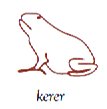 |
|
15 (135 + 365 = 500) |
May 16 (136) |
17 |
18 (*58) |
|
ºMay 11 |
12 (132) |
13 |
14 (*54) |
|
4-18 (473
= 108 + 365) |
'April 19 |
4-20 |
21 (111) |
|
"April 4 |
5 (501 - 41 = 460) |
6 (*16) |
7 |
|
MARCH 12 |
13 |
3-14 (73) |
15 |
|
417 (= 51 + 366) |
52 (= 136 - 84) |
53 (= 73 - 20) |
54 (= *58 - 4) |
|
... The Mahabharata
insists on six as the
number of the Pleiades as well
as of the mothers of Skanda
and gives a very broad and wild
description of the birth and the
installation of Kartikeya
'by the assembled gods ... as
their generalissimo', which is
shattering, somehow, driving
home how little one understands
as yet. The least which can be
said, assuredly: Mars was
'installed' during a more or
less close conjunction of all
planets; in Mbh. 9.45 (p. 133)
it is stressed that the powerful
gods assembled 'all poured water
upon Skanda, even as the
gods had poured water on the
head of Varuna, the lord
of waters, for investing him
with dominion'. And this
'investiture' took place at the
beginning of the Krita Yuga,
the Golden Age
... |
The ua type of glyph may have been
designed in order to incorporate also the
rainbow down in the southwest (toga), i.e.
of the twin beginning at the 'urine' flow
below the ecliptic:



 |
 |
 |
 |
 |
 |
|
*Ca14-18 |
*Ca14-19 |
*Ca14-20 (383) |
*Ca14-21 (392 - 8) |
*Ca14-22 |
*Ca14-23 |
|
te honu paka |
te henua |
honu kau |
te mata |
te honu |
kua heheu |
|
1h (15.2)
β Phoenicis (15.1), υ
Phoenicis, ι Tucanae (15.6),
η Ceti, ζ Phoenicis (15.7) |
Al Batn Al Hūt-26 (Belly of
the Fish) /
Revati-28 (Prosperous) / 1-iku
(Field Measure)
MIRACH (Girdle) = β
Andromedae, KEUN MAN MUN
(Camp's South Gate) = φ
Andromedae
(16.0),
ANUNITUM = τ Piscium
(16.5),
REVATI (Abundant) = ζ
Piscium
(16.9)
REGULUS (α Leonis)
|
ν Phoenicis (17.4), κ
Tucanae (17.6) |
no star listed (18) |
ADHIL (Garment's Train) = ξ
Andromedae
(19.3), θ Ceti (19.7) |
KSORA (Knee) = δ Cassiopeiae
(20.1), ω Andromedae (20.6),
γ Phoenicis (20.8) |
|
April 5 (460) |
6 (8 + 88) |
7 |
8 |
9 (464 = 99 + 365) |
10 (100) |
|
372 |
373 = 365 + 8 |
374 |
375 |
376 = 464 - 88 |
377 |
|
... The
ordinary year in the
previous Roman calendar
consisted of 12 months, for
a total of 355 days. In
addition, a 27-day
intercalary month, the
Mensis Intercalaris, was
sometimes inserted between
February and March. This
intercalary month was formed
by inserting 22 days after
the first 23 or 24 days of
February; the last five days
of February, which counted
down toward the start of
March, became the last five
days of Intercalaris. The
net effect was to add 22 or
23 days to the year, forming
an intercalary year of 377
or 378 days ... |
|
At the time when Betelgeuze
(*88) was at 0h Regulus
would have culminated (at
21h) in 8 January and this
was 160 (= 80 + 88 - 8) days
before Betelgeuze would rise
with the Sun. This distance
was in principle
(disregarding the proper
motions of the stars)
preserved through the
millenia and at the time of
rongorongo Betelgeuze rose
in day 168 (= 80 + 88), i.e.
in June 17, with Regulus
culminating (at 21h) in
April 6 (96) which was 168 -
96 = 72 days earlier. 72 =
360 / 5 and 360 - 72 = 288
(October 15):
... The Julian calendar day
Thursday, 4 October 1582 was
followed by the first day of
the Gregorian calendar,
Friday, 15 October 1582 (the
cycle of weekdays was not
affected)
...
And according to Manuscript
E the double-canoe of
Hotu A Matua arrived to
Easter Island in 15 October:
... The canoes of Ava Rei
Pua and of Hotu
were seen near the
(off-shore) islets. On the
fifteenth day of the month
of October (tangaroa
uri) the canoe of
Hotu and the canoe of
Ava Rei Pua landed. On
the fifteenth day of the
month of October (tangaroa
uri), Nonoma
left the house during the
night to urinate outside. At
this point Ira called
out to Nonoma, 'Look
at the canoe!' Nonoma
ran, he quickly went to
Te Hikinga Heru (a
ravine in the side of the
crater Rano Kau) and
looked around. There he saw
the double canoe way out
near the (offshore) islets,
and the two (hulls of the
canoe) were lashed together.
He ran and returned to the
front of the house. He
arrived and called into the
house: 'Hey you! This canoe
has arrived during the night
without our noticing it!'
Ira asked Nonoma,
'Where is the canoe, which
you say is lying out there
(in the water)?' Nonoma's
voice came back: 'It is out
there (in the water) close
to the (offshore) islets!
There it lies, and the two
(hulls) are lashed
together.' The four of them
(corrected for 'the six of
them') went out and picked
up leaves (on branches) to
give signals. They picked
them up, went and arrived at
Te Hikinga and saw
the canoe. Raparenga
got up, picked up the
leaves, took them in his
hands, and waved, waved,
waved, waved
...
 |
... During his descent the ancestor still
possessed the quality of a water spirit, and
his body, though preserving its human
appearance, owing to its being that of a
regenerated man, was equipped with four
flexible limbs like serpents after the
pattern of the arms of the Great Nummo. The
ground was rapidly approaching. The ancestor
was still standing, his arms in front of him
and the hammer and anvil hanging across his
limbs. The shock of his final impact on the
earth when he came to the end of the
rainbow, scattered in a cloud of dust the
animals, vegetables and men disposed on the
steps. When calm was restored, the smith was
still on the roof, standing erect facing
towards the north, his tools still in the
same position. But in the shock of landing
the hammer and the anvil had broken his arms
and legs at the level of elbows and knees,
which he did not have before. He thus
acquired the joints proper to the new human
form, which was to spread over the earth and
to devote itself to toil ...
There was a Knee (Ksora) at April 10
(465 = 365 + 100), which star at 60º N could
have
defined 30º above as the limit of the polar
'cap' region:
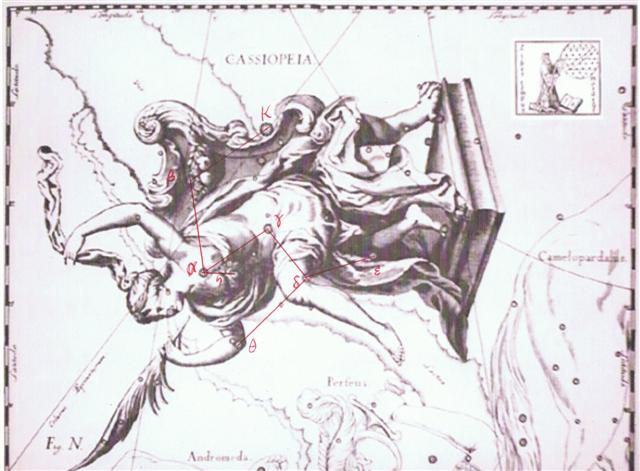
A page lifted from my preliminary glyph type
dictionary:
|
Toga glyphs are used to
mark the end of Sun periods,
e.g. at the end of the day:
|
|
My colour chart for the planets
(the week) has here been
extended (and indeed there is no
reason why it should end at any
point):
|
number of glyphs
and planets |
|
Venus |
Saturn |
Sun |
Moon |
Mars |
Mercury |
Jupiter |
|
3 |
4 |
5 |
6 |
7 |
8 |
9 |
|
10 |
11 |
12 |
13 |
14 |
15 |
16 |
|
17 |
18 |
19 |
20 |
21 |
22 |
23 |
|
24 |
25 |
26 |
27 |
28 |
29 |
30 |
|
31 |
32 |
33 |
34 |
35 |
36 |
37 |
|
38 |
39 |
40 |
41 |
42 |
43 |
44 |
The chart shows how the ordinal
number of a glyph in a line can
(at least sometimes) be
correlated with the planets. The
colours are applied by me purely
in order to make it easier to
see which planet will 'rule'
which glyph.
Furthermore, it is important to
notice that the numbers in the
chart are not related to the
numbers which 'characterizes'
respective planet. The beginning
of time is in the dark and only
when some light source appears
does counting begin. Counting
the nights of the month, for
instance, means you will begin
from the time when the moon
reappears. Night number 1 means
there is a minimum of one dark
night in the past.
Venus apparently was used (at
least ideally) to mark when the
year was beginning. Also she has
her dark periods (8 nights
long). From the beginning of the
K text it is clear that there
were 2 dark nights before Venus
reappeared:
 |
 |
 |
 |
 |
 |
|
Ka1-1 |
Ka1-2 |
Ka1-3 |
Ka1-4 |
Ka1-5 |
Ka1-6 |
|
- |
1 |
2 |
3 |
4 |
The 3 fingers of fire (5)
suddenly becomes understandable.
In Ka1-3 they are announced by
Venus.
The numbers for the planets are
not the same as the ordinal
numbers for the glyphs. We need
a separate chart:
|
numbers and planets |
|
Venus |
Saturn |
Sun |
Moon |
Mars |
Mercury |
Jupiter |
|
1 |
2 |
3 |
4 |
5 |
6 |
7 |
|
8 |
9 |
10 |
11 |
12 |
13 |
14 |
Venus has here not only number 1
but also number 8, which is of
central importance in the
rongorongo system. 8 * 29.5
= 236.
Sun has number 3 and 10. He will
end with number 10, and this
happens after 8 months. 236 + 8
* 8 = 300 = 10 * 30. |
It was said that the Sun followed the
custom of Venus as Morning Star and
therefore could not begin until after 8
dark days (corresponding to the period
of nights when Venus was invisible
before returning in the east),
... At the time when Betelgeuze (*88)
was at 0h Regulus would have culminated
(at 21h) in 8 January and this was 160
(= 80 + 88 - 8) days before Betelgeuze
would rise with the Sun ...
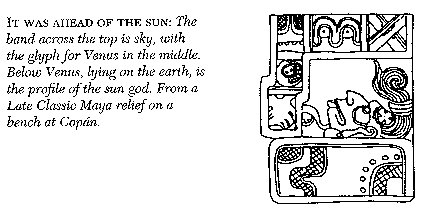
and he could not go past midsummer
(noon) because Venus never passed across
the sky from the east to the west. The
synodic orbits below show 24 consecutive
appearances of Venus (from Anthony F.
Aveni, Skywatchers):
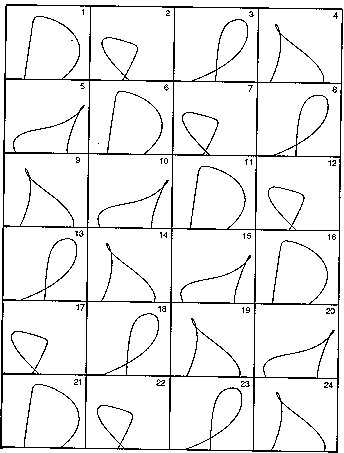
|































